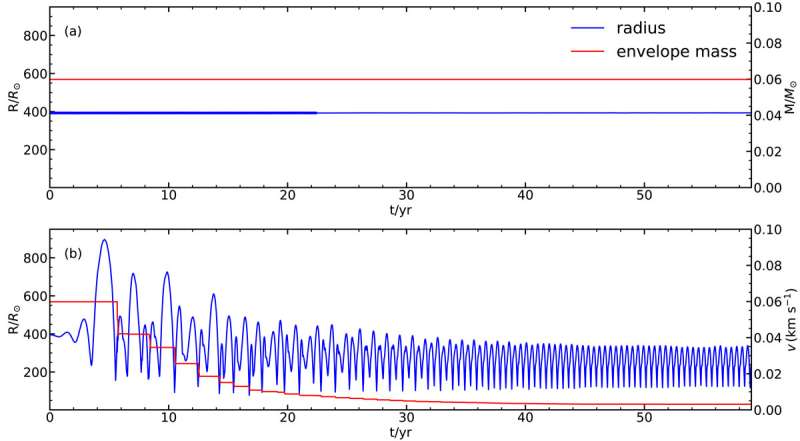Hydrodynamical simulations for the common-envelope wind model for Type Ia supernovae

Ph.D. candidate Cui Yingzhen and Prof. Meng Xiangcun from the Yunnan Observatories of the Chinese Academy of Sciences (CAS) performed hydrodynamic simulations on the common-envelope wind model of Type Ia supernovae (SNe Ia), and revealed the mass loss mechanism and the main observational features of white dwarf binaries in the common-envelope wind phase.
The study was published in Astronomy & Astrophysics.
SNe Ia are some of the most energetic events in the universe. They are used as cosmological distance indicators, which have led to the discovery of the accelerating expansion of the universe.
One of the most popular progenitor models of SNe Ia is the single-degenerate model, in which a carbon-oxygen white dwarf accretes material from a non-degenerate companion star to increase its mass, and eventually undergoes a thermonuclear explosion. The problem with this model is that when the mass transfer rate exceeds a certain critical value, the accreted envelope of the white dwarf expands and eventually forms a common envelope around the binary system, which may prevent the occurrence of SNe Ia.
The common-envelope wind model is a modified single-degenerate model that can in principle address the above-mentioned problem by suggesting a strong mass loss at the surface of the common envelope. However, it is not clear how the mass loss at the surface of the common envelope arises and what the observational characteristics of such systems are.
The researchers carried out detailed hydrodynamic simulations of common-envelope wind model and found that such systems are always dynamically unstable and consequently produce dramatic mass loss, resulting in an envelope mass of only a few thousands of solar mass.
By analyzing the internal structure, they found that this instability was driven by ionization-recombination processes of hydrogen and helium in the envelope, the same mechanism as the pulsating excitation of classical Cepheids. In the Hertzsprung-Russell diagram, the center of the evolutionary trajectory of the common-envelope wind model was also located within the classical Cepheid instability strip, implying that this system may appear as periodic variable stars.
This result can provide theoretical guidance for the subsequent observational search for progenitor system of SNe Ia.
More information: Yingzhen Cui et al, Hydrodynamical simulations for the common-envelope wind model for Type Ia supernovae, Astronomy & Astrophysics (2022). DOI: 10.1051/0004-6361/202141335
Journal information: Astronomy & Astrophysics
Provided by Chinese Academy of Sciences



















